HTML
--> --> -->2.1.General description
The generators used for this study are PYTHIA, a collider physics generator, and EPOS, QGSJET and SIBYLL, which are cosmic ray collision generators. They can be split in three categories according to the models on which they are based. PYTHIA is a parton based generator and it simulates parton interactions and parton showers, where the hadronization is treated using the Lund string fragmentation model [13, 14]. Another category are the generators based on the Regge theory, such as QGSJET and SIBYLL. These models treat soft and semi-hard interactions as Pomeron exchanges ("soft" and "semi-hard" Pomerons), but also mix perturbative methods in the treatment of hard interactions [14, 15]. EPOS is in a distinct category in which the parton based description is mixed with aspects from the Regge theory [14]. The focus of this study is on minimum bias physics measurements and the generators used, especially the cosmic ray ones, are developed for the description of such observables. The selection of these particular generators is justified by their varied usage and basic assumptions, while at the same time sharing similarities, as well as having been tuned to the LHC data, as will be discussed below.PYTHIA is one of the most widely used Monte Carlo event generators for collider physics with an emphasis on pp interactions. It is mainly based on the Leading Order (LO) QCD, having implemented LO matrix elements and usually using LO PDF sets (NLO PDF sets are also available) [7, 16, 17]. The main event in a pp collision (internally called "hard process") can be represented by a plethora of processes like elastic and diffractive (described using Pomerons) [7, 13, 18], soft and hard QCD processes, electroweak processes, top quark production etc. The generator also implements parton showers (Initial State Radiation, ISR, and Final State Radiation, FSR) in Leading Log (LL) approximation with matching and merging methods between them and the hard processes [7, 16]. Given that the colliding hadrons have a complex partonic structure, other partonic interactions aside from the main event are expected. These are called multi-parton interactions (MPI) and are usually soft in nature, but the momentum transfer can also reach the hard interaction energy scale. PYTHIA implements a description of both types and also of the beam remnants which form after the extraction of MPI initiator partons [7]. The hadronization mechanism is based on the Lund string fragmentation model [7].
The Parton-Based Gribov-Regge Theory is an effective field theory using concepts from QCD in which the elementary interactions between the constituent partons of nucleons/nuclei proceed via exchanges of parametrized objects called Pomerons, which have the quantum numbers of vacuum [19, 20]. In this theory the elementary collisions are treated as a sum of soft, semi-hard and hard contributions. If one considers a cutoff value of the momentum transfer squared of
The generator EPOS is based on the effective theory described above [2]. EPOS is an acronym for Energy conserving quantum mechanical approach, based on Partons, parton ladders, strings, Off-shell remnants, and Splitting of parton ladders [21]. In EPOS, the interaction of the two beam particles is described by means of Pomeron exchanges. As discussed above, these Pomerons can be soft, semi-hard or hard. A soft Pomeron can be viewed from a phenomenological standpoint as two parton ladders (or cut Pomeron) connected to the remnants by two color singlets (legs) from the parton sea [22]. A cut Pomeron can be viewed as two strings which fragment to create hadrons. The flavors of the string ends need to be compensated within the remnants. Thus, particle production in EPOS comes from two sources, namely cut Pomerons and the decay of remnants [22]. Through a recent development (from EPOS 1.99 onwards), EPOS is now a core-corona model. The core represents a region with a high density of string segments that is larger than some critical density for which the hadronization is treated collectively, and the corona is the region with a lower density of string segments for which the hadronization is treated non-collectively. The strings from the core region form clusters which expand collectively. This expansion has two components, namely radial and longitudinal flow. Through this core-corona approach, EPOS takes into account effects not accounted for in other HEP models [2]. In EPOS, in the case of multiple scatterings (multi-Pomeron exchanges), the energy scales of the individual scatterings are taken into account when calculating the respective cross-sections, while in the other models based on the Gribov-Regge theory this is not the case. This leads to a consistent treatment of both exclusive particle production and cross-section calculation, taking energy conservation into account in both cases [19, 22]. The multiplicity and inelastic cross-section predictions of the model are directly influenced by energy-momentum sharing and beam remnant treatment [22].
The elementary scatterings in QGSJET are also treated as Pomeron exchanges [15]. QGSJET is based on the Quark-Gluon string model, which is in turn based on the Gribov-Regge model [23]. In this model the Pomeron exchange can be viewed as an exchange of a non-perturbative gluon pair. Each of the colliding protons can be considered as a system of a quark and a diquark with opposite transverse momenta. The quark from the first proton exchanges a non-perturbative gluon with the diquark from the second proton and viceversa, thus creating two quark-gluon strings which will decay according to the fragmentation functions to create hadrons [24]. In a similar manner to EPOS, the soft (non-perturbative) and hard (perturbative) contributions are separated by a cutoff value of
SIBYLL is based on the dual parton model (DPM), using the mini-jet model for hard interactions and the Lund string fragmentation model for hadronization [26, 27]. Similarly to both EPOS and QGJSET, soft and hard interactions are separated by a transverse momentum scale cutoff value. The soft interactions are treated using the dual parton model (DPM) in which the nucleon is treated as consisting of a quark and a diquark, and similar to the Quark-Gluon string model described above, a quark (diquark) from the projectile combines with the diquark (quark) from the target to form two strings which are fragmented separately using the Lund string fragmentation model. In SIBYLL 1.7, the cutoff value was set to
2
2.2.Versions used in the study
The default tune for PYTHIA 8.186 is Tune 4C with the CTEQ6L1 LO PDF set as the default one [7, 28]. Tune 4C (default from version 8.150 onwards [29]) is obtained starting from Tune 2C for which the Tevatron data have been used, by varying MPI and color reconnection parameters to fit the measurements for minimum bias (MB) and underlying event (UE) observables from the ALICE and ATLAS experiments at various collision energies (0.90, 2.36 and 7 TeV). The observables used are for example: charged multiplicity and rapidity distributions, transverse momentum distributions, mean transverse momentum distributions as a function of charged multiplicity, transverse momentum sum densities etc. Tune 2M is obtained in a similar manner to 2C, using the measurements from the CDF experiment at Tevatron, but uses the modified PDF set MRST LO** instead of the CTEQ6L1 LO PDF set [30]. From here on, PYTHIA 8.186 with Tune 2M will be refered to as PYTHIA 8.1 2M.PYTHIA 8.219 has the Monash 2013 tune as its default (with the NNPDF3.3 QCD+QED LO PDF set) [7, 29]. The Monash 2013 tune has been created for a better description of minimum bias and underlying event observables. Similar observables as for the previous tune have been used, with the measurements from the ATLAS and CMS experiments, and the charged pseudorapidity distribution from TOTEM in the forward region. The flavor-selection parameters of the string fragmentation model have been re-tuned using a combination of data from PDG and from the LEP experiments, resulting in an overall increase of about 10% in strangeness production, and a similar decrease of the production of vector mesons. The kaon yields have clearly improved with respect to the CMS measurements, and the yields of hyperons are also slightly improved. The minimum bias charged multiplicity has also increased by about 10% in the forward region [31].
EPOS LHC fundamental parameters are tuned to the cross-section measurements from the TOTEM experiment at
QGSJETII-04 is distinguished from the previous version, QGSJETII-03, by taking into account all significant enhanced Pomeron diagram contributions, including Pomeron loops, and the tuning to the new LHC data [32]. As QGSJET is used for high energy cosmic rays studies, the current version of the generator has been tuned to the LHC measurements for observables to which the extensive air shower (EAS) muon content is sensitive. Examples of such observables are: charged particle multiplicities and densities, anti-proton and strange particle yields etc. QGSJETII-03 predicts a steeper increase in multiplicity in pseudorapidity plots from
SIBYLL is a relatively simpler model and emphasis is put on describing observables on which the evolution of extensive air showers depends, like energy flow and particle production in the forward region [34]. In SIBYLL 2.3 soft gluons can also be exchanged between sea quarks or sea and valence quarks. A new feature in version 2.3 is the beam remnant treatment which is similar to that in QGSJET. This new treatment allows particle production in the forward region to be tuned without modifying the string fragmentation parameters. A major tuning procedure has been done for the description of leading particle measurements from the NA22 and NA49 experiments [4]. SIBYLL 2.3 has also been tuned using measurements from
This study treats five distinct aspects: charged energy flow, charged particle distributions, charged hadron production ratios and
Charged energy flow is computed as the total energy of stable charged particles (p,
$\frac{1}{N_{\rm int}}\frac{{\rm d}E_{\rm total}}{{\rm d}\eta}=\frac{1}{\Delta\eta}\Bigg(\frac{1}{N_{\rm int}}\sum_{i=1}^{N_{\rm part},\eta} E_{i,\eta}\Bigg),$  | (1) |
There are four event classes considered for the charged energy flow: inclusive minimum bias events, hard scattering events, diffractive enriched events and non-diffractive enriched events. The inclusive minimum bias events are required to have at least one charged particle in the range: 1.9
The purity of the diffractive enriched and non-diffractive enriched events samples have been studied for both versions of PYTHIA (as the generator has readily accessible event type information) and are about 94% and 92%, respectively. In Fig. 1, the transverse momentum scale distributions of the hardest parton collisions from hard and soft (non-hard and non-diffractive) events, obtained with PYTHIA 8.186, are shown. As can be seen, the peaks are reasonably well separated with
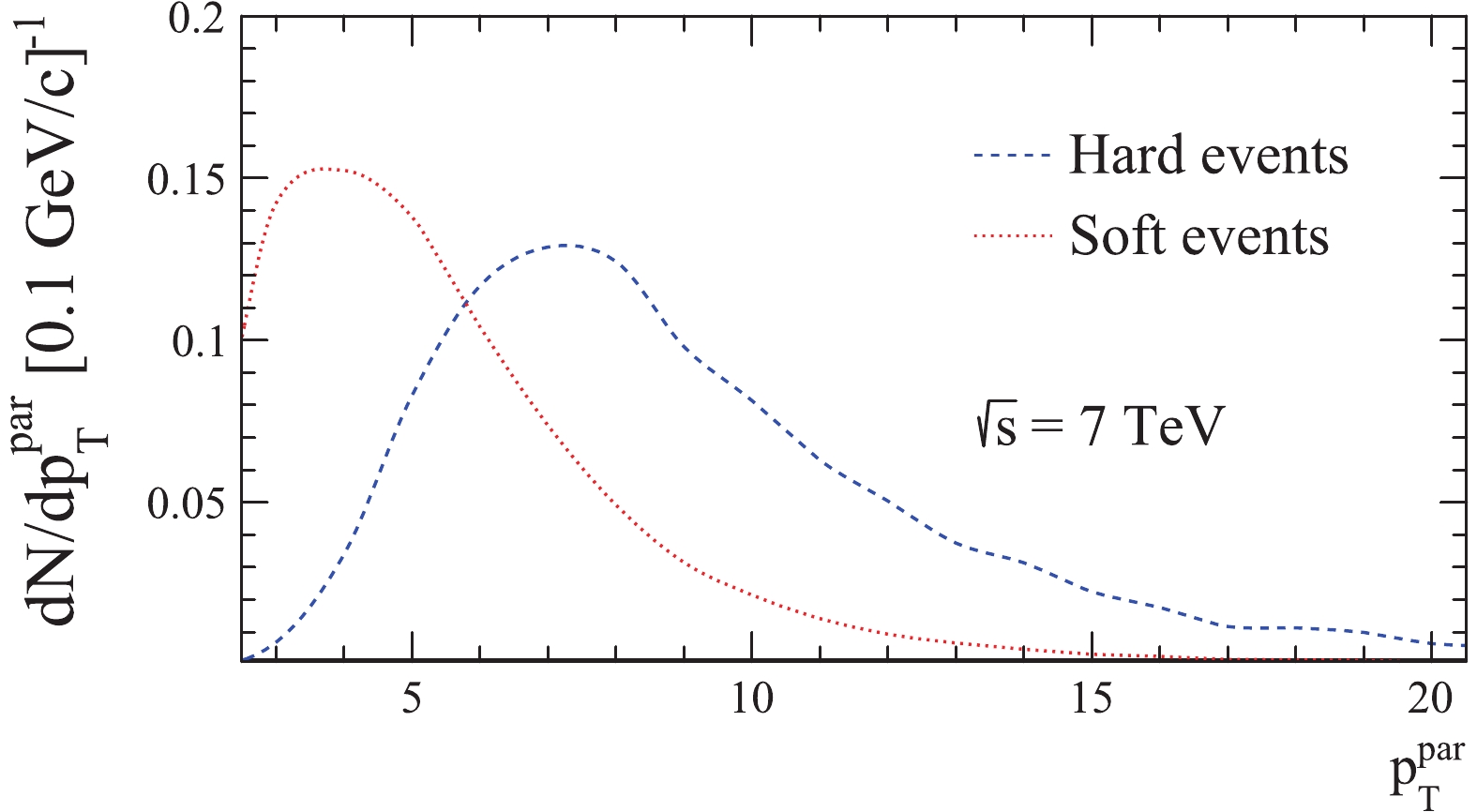 Figure1. (color online) Transverse momentum scale of the hardest subprocess obtained with PYTHIA 8.186 for hard and soft events. The distributions were normalized to the number of visible events for each event class.
Figure1. (color online) Transverse momentum scale of the hardest subprocess obtained with PYTHIA 8.186 for hard and soft events. The distributions were normalized to the number of visible events for each event class.The number of visible events for the different event classes are given in Table 1.
| Generator |   |   |   |
| PYTHIA 8.186 | 88.20% | 5.63% | 7.04% |
| PYTHIA 8.219 | 88.11% | 5.05% | 7.10% |
| EPOS LHC | 84.92% | 4.87% | 6.26% |
| QGSJETII-04 | 86.72% | 7.94% | 5.52% |
| SIBYLL 2.3 | 89.55% | 6.43% | 6.47% |
| PYTHIA 8.1 2M | 86.89% | 5.08% | 7.97% |
Table1.Number of visible events for different event classes.
The transverse momentum, pseudorapidity and multiplicity distributions of charged stable particles (p, π, K, e, μ) are presented in Figs. 3-6. The distributions were scaled with the number of visible events from the sample. The visible events are required to contain a minimum of one charged particle satisfying the criteria listed below:
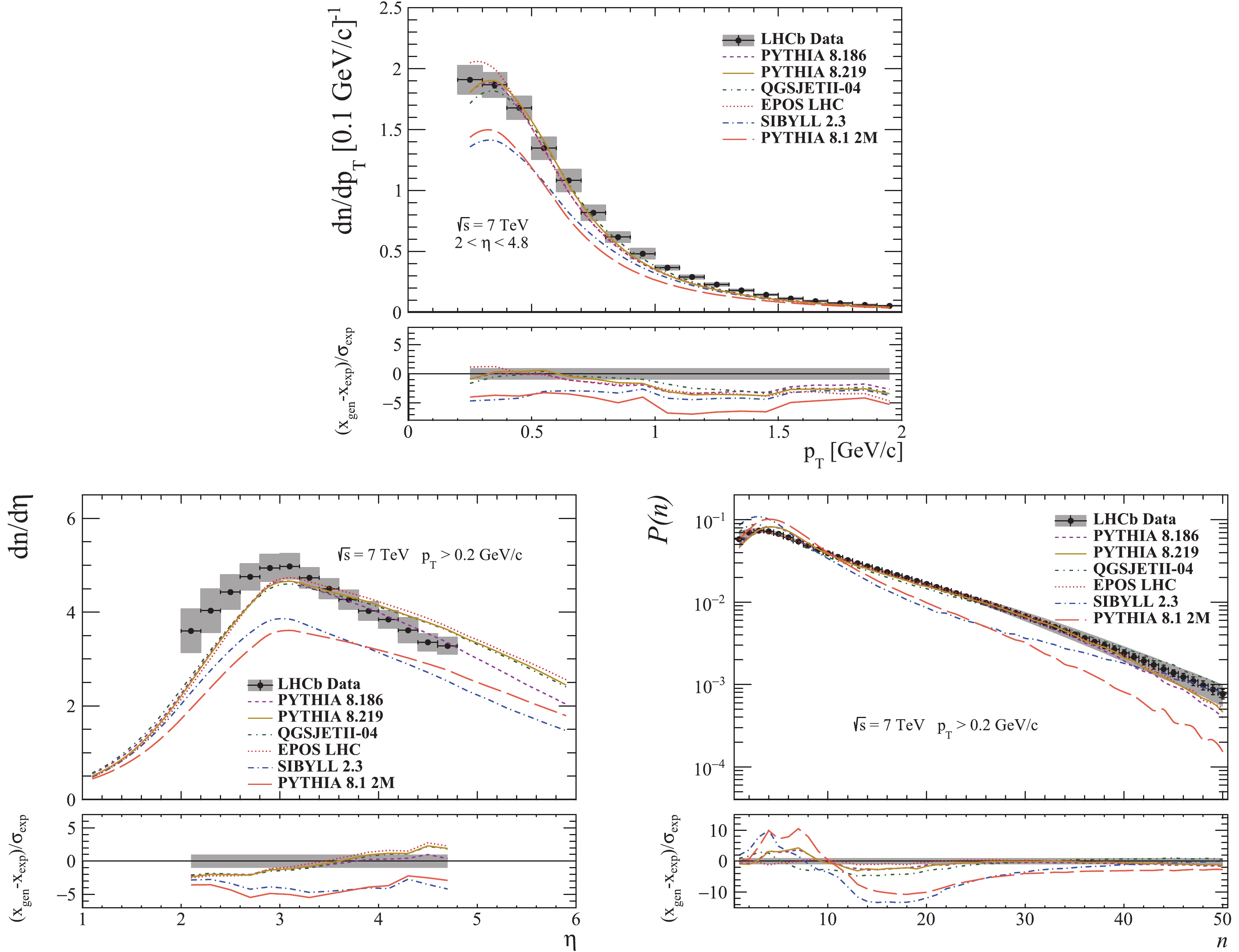 Figure3. (color online) Transverse momentum, pseudorapidity and multiplicity distributions for prompt charged particles in the kinematic region
Figure3. (color online) Transverse momentum, pseudorapidity and multiplicity distributions for prompt charged particles in the kinematic region 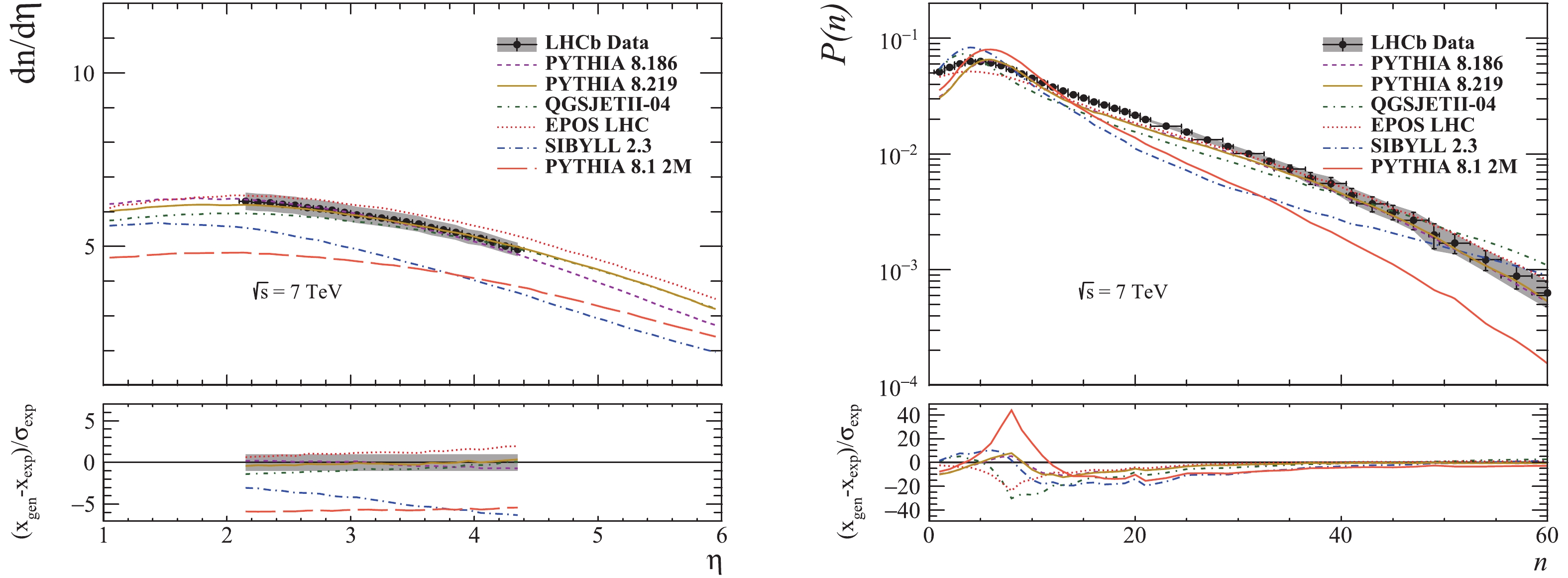 Figure4. (color online) Pseudorapidity and multiplicity distributions for prompt charged particles in the kinematic region
Figure4. (color online) Pseudorapidity and multiplicity distributions for prompt charged particles in the kinematic region 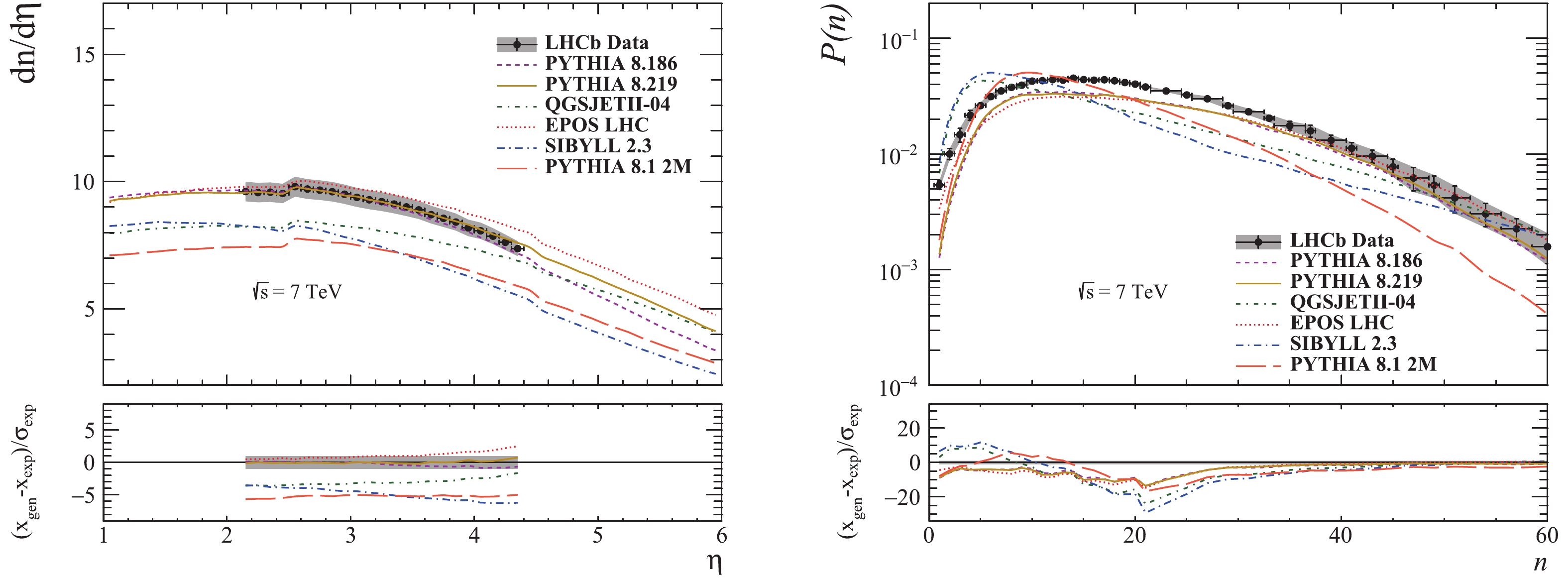 Figure5. (color online) Pseudorapidity and multiplicity distributions for prompt charged particles in the kinematic region
Figure5. (color online) Pseudorapidity and multiplicity distributions for prompt charged particles in the kinematic region  Figure6. (color online) Prompt charged particle pseudorapidity distribution in the kinematic region
Figure6. (color online) Prompt charged particle pseudorapidity distribution in the kinematic region ● Figure 3:
● Figure 4:
● Figure 5:
● Figure 6:
The number of minimum bias and hard events with a minimum of one charged particle in the range
| Generator | minimum bias | hard events [% of minbias] |
| PYTHIA 8.186 | 87.28% | 43.90% |
| PYTHIA 8.219 | 87.17% | 42.83% |
| EPOS LHC | 83.81% | 44.86% |
| QGSJETII-04 | 85.57% | 54.01% |
| SIBYLL 2.3 | 88.19% | 46.68% |
| PYTHIA 8.1 2M | 85.87% | 37.37% |
Table2.Number of events with a minimum of
For all distributions mentioned above, pull plots of (
A particle is defined as prompt if the sum of mean proper lifetimes of its ancestors is less than 10 ps, as in [37-39].
The prompt charged hadron production ratios
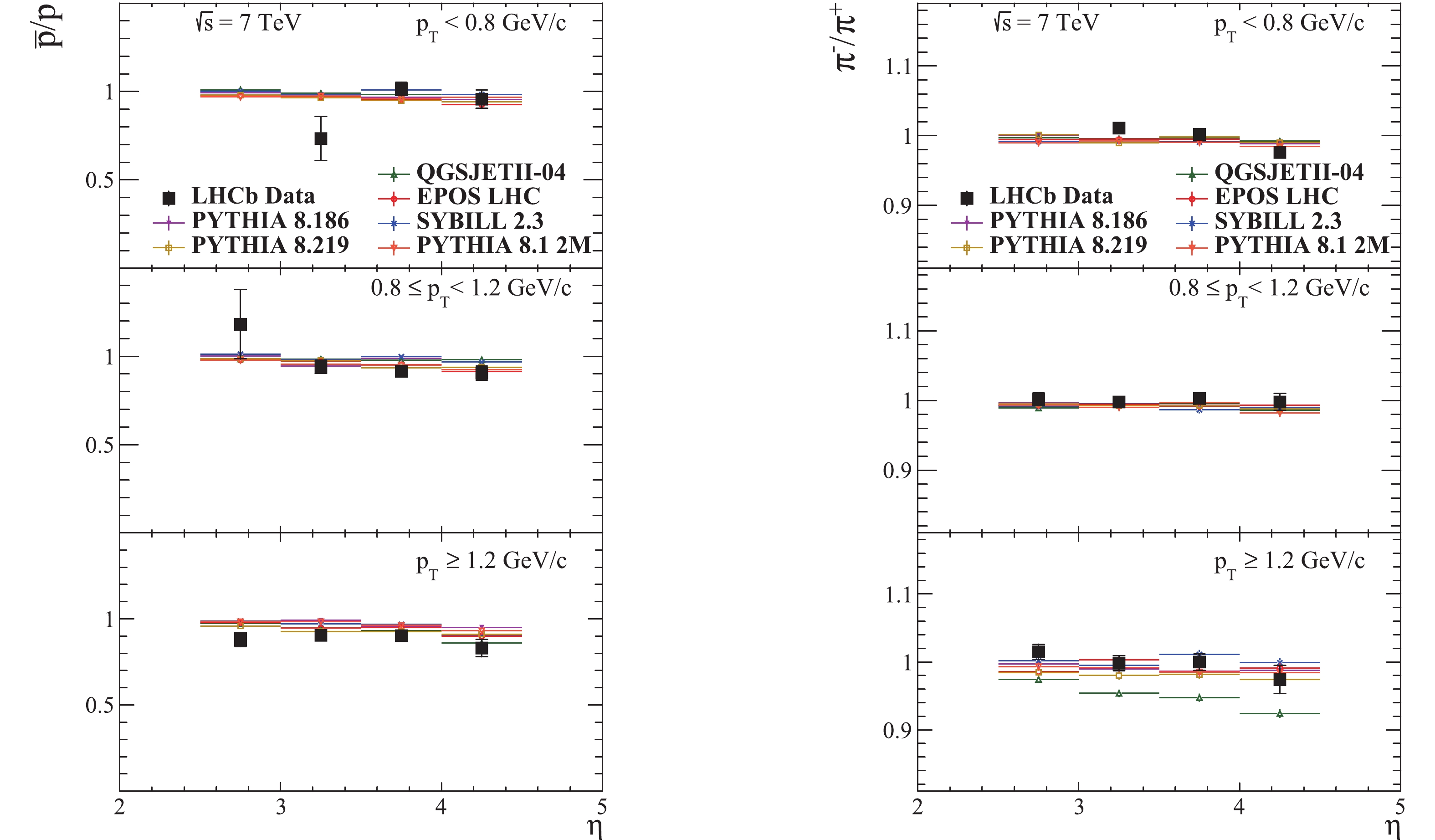 Figure9. (color online) Prompt charged hadron ratios as a function of pseudorapidity in the kinematic region
Figure9. (color online) Prompt charged hadron ratios as a function of pseudorapidity in the kinematic region 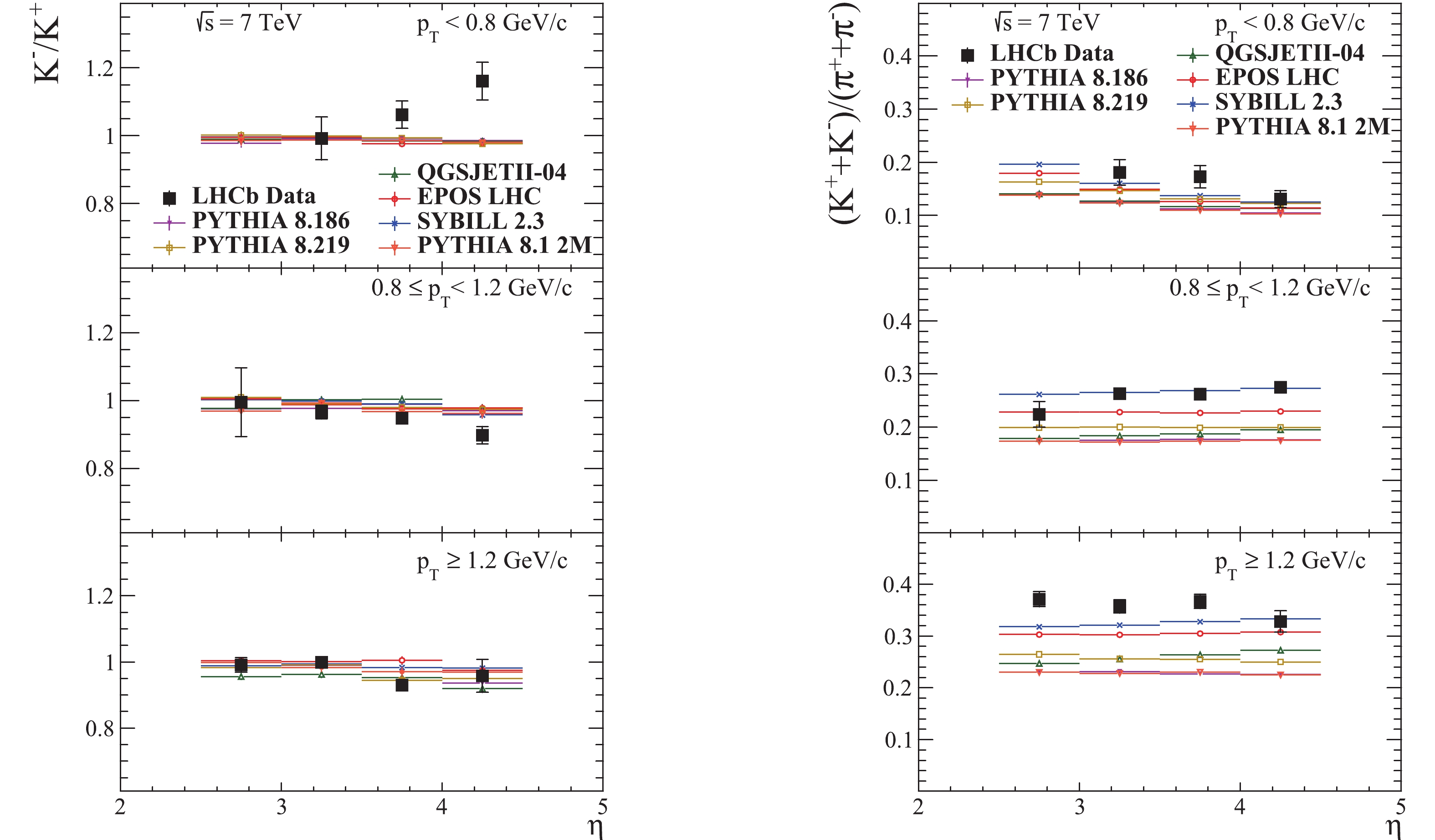 Figure10. (color online) Prompt charged hadron ratios as a function of pseudorapidity in the kinematic region
Figure10. (color online) Prompt charged hadron ratios as a function of pseudorapidity in the kinematic region 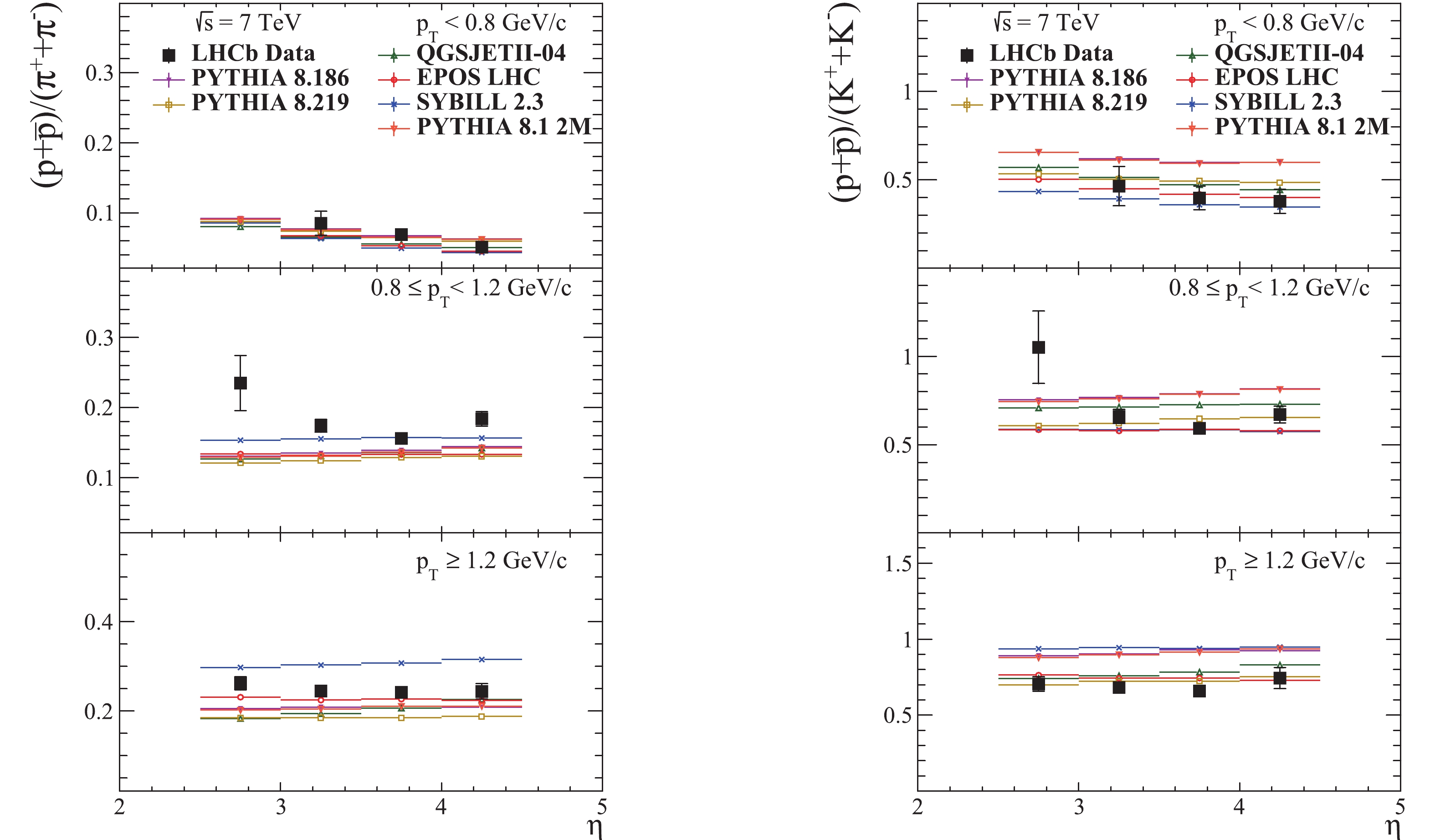 Figure11. (color online) Prompt charged hadron ratios as a function of pseudorapidity in the kinematic region
Figure11. (color online) Prompt charged hadron ratios as a function of pseudorapidity in the kinematic region The prompt
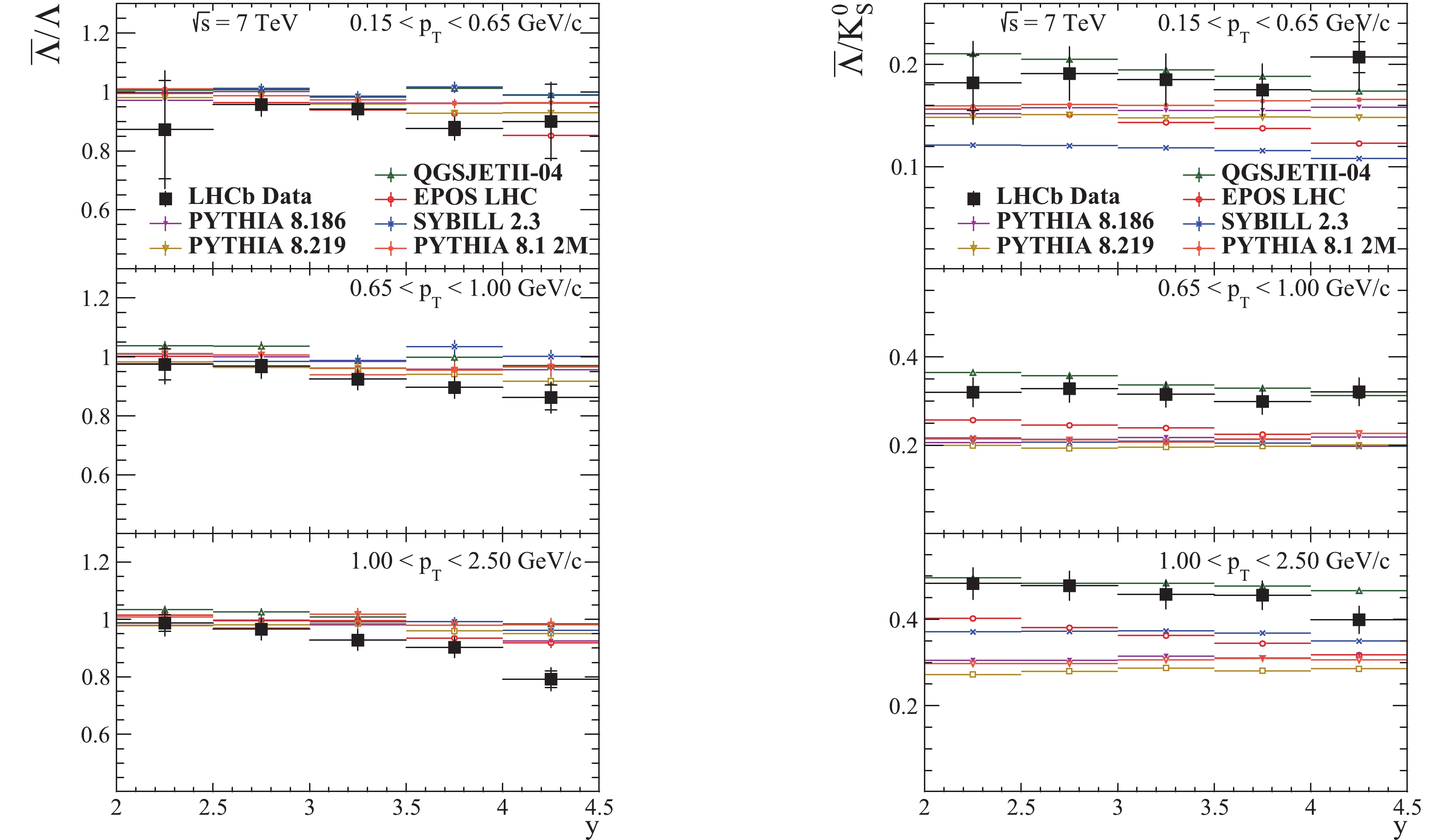 Figure12. (color online) Prompt
Figure12. (color online) Prompt  Figure13. (color online) Prompt
Figure13. (color online) Prompt  Figure14. (color online) Prompt
Figure14. (color online) Prompt The statistical uncertainties of the MC predictions are negligible, reaching a maximum of about 3% in the least populated bins at the edges of the considered phase space regions, while for the rest of the bins the uncertainties are of the order of 0.1%.
The sources of the reference measurements used in the plots are given at the end of the captions.
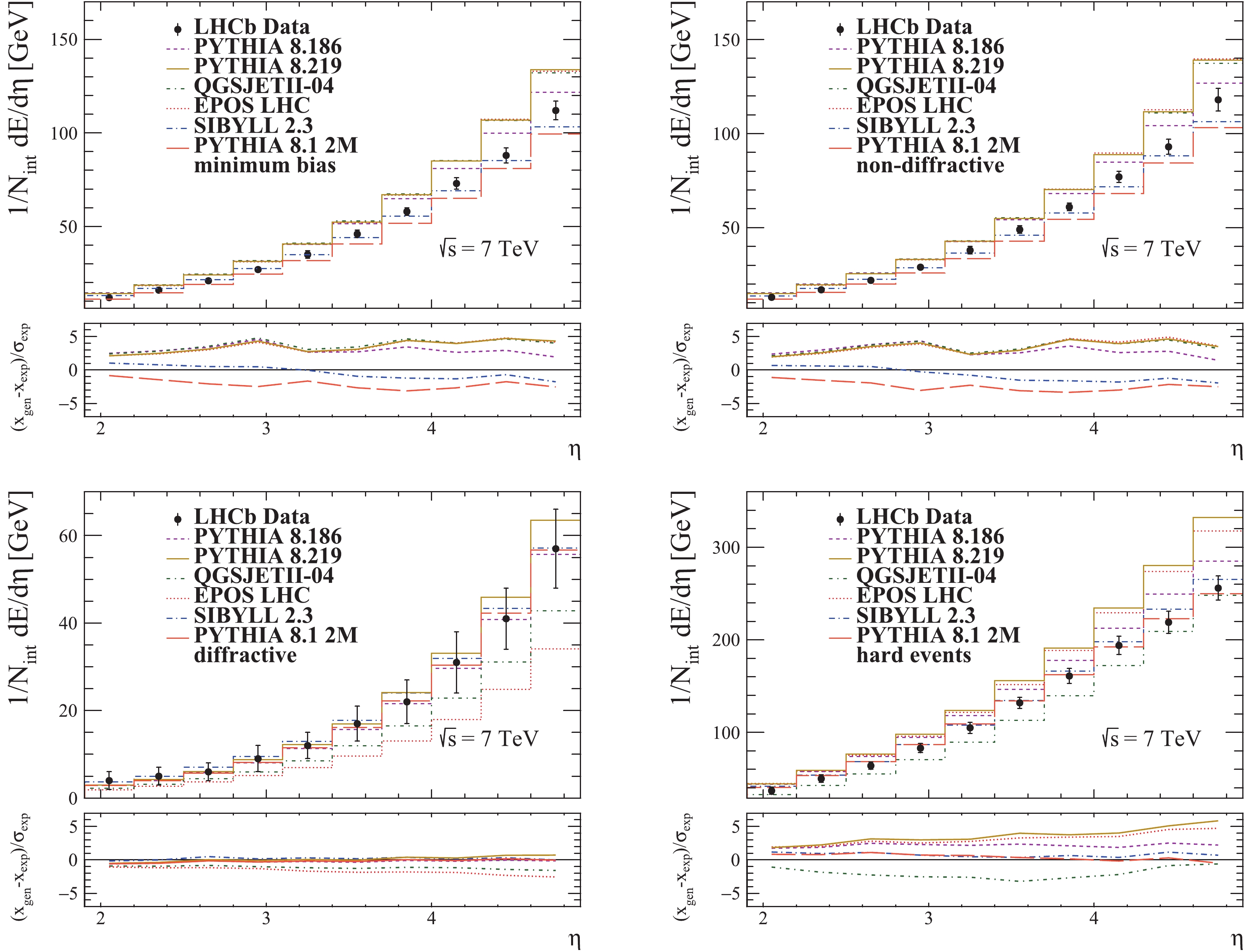 Figure2. (color online) Charged energy flow for different classes of events from pp collisions at
Figure2. (color online) Charged energy flow for different classes of events from pp collisions at The predictions of PYTHIA 6 versions [36] seem to be reasonably good in the central region (with the exception of diffractive events), but largely underestimate the measured values in the forward region in all cases. PYTHIA 8.135 predictions have a good description for the inclusive minimum bias, diffractive enriched and non-diffractive enriched event classes, but overestimate the measured values for the hard events.
PYTHIA 8.1 2M exhibits a slight decrease in overall values relative to version 8.135 (which uses the older Tune 1 [29]) for the minimum bias, non-diffractive enriched and hard event classes. The description for the hard event class is improved, while for the other two event classes a tendency to underestimate is observed. There is no major difference between the two versions for the diffractive event class.
With the exception of SIBYLL, a generator tuned to reproduce energy flow measurements, PYTHIA 8.186 seems to give the best description overall of the LHC-tuned generators. Its predictions for the diffractive enriched class are very similar to version 8.135, but for the other event classes the predictions are further away from the measurements, exhibiting a constant tendency to overestimate.
PYTHIA 8.219 gives a good description of the charged energy flow for the diffractive enriched class, and is similar to version 8.186. One can see that the predictions tend to increasingly overestimate in the forward region, but are similar to version 8.186 in the central region. The differences can be explained by the 10% increase in charged particle densities in the forward region implemented with the Monash 2013 tune [31].
EPOS 1.99 [36] describes reasonably well the charged energy flow for inclusive minimum bias, hard and non-diffractive enriched event classes, slightly overestimating the measurements in the last two bins. It underestimates the charged energy flow for diffractive processes in the forward region.
EPOS LHC predictions are very similar to those of PYTHIA 8.219 for all event classes except the diffractive enriched class, where similarly to the previous version, it underestimates the charged energy flow. As one can see in the restricted minimum bias plot, the apparent overestimate of the soft process component is similar to PYTHIA 8.219. Compared to the previous version, we observe that the predictions are worse (except for diffractive events). Overall, EPOS LHC overestimates the measurements, with an increasing trend in the forward pseudorapidity region.
The predictions of QGSJET01 and QGSJETII-03 from [36] are similar for the inclusive minimum bias class and they overestimate the charged energy flow. QGJSET01 gives a better description of the diffractive and hard event classes in the central region, but tends to overestimate the measurements for hard events and underestimates them for the diffractive events in the forward region. The general trend of QGSJETII-03 is that of underestimation for the hard events class.
The predictions of QGSJETII-04 are similar to the previous versions for the inclusive minimum bias event class. The description of the charged energy flow for hard events is underestimated even more than in the case of QGSJETII-03. The diffractive component description is similar to QGSJETII-03, but with a slightly larger tendency to underestimate. For the other event classes the differences with respect to the measured LHCb charged energy flow are significant. Although the absolute values are clearly far from the experimental values, the shapes are well described. QGSJETII-04 is very similar to EPOS LHC and PYTHIA 8.219 in its description of the charged energy flow for inclusive minimum bias and non-diffractive enriched event classes.
SIBYLL 2.1 prediction [36] describes very well the measurements for inclusive minimum bias events. It also gives a reasonably good description of the diffractive events, as the values are within the error bars, although a tendency to underestimate them can be seen. The hard event component is well described in the central region, but it is overestimated in the forward region.
SIBYLL 2.3 seems to give the best prediction for all event classes (on par with PYTHIA 8.186 for the diffractive enriched class). It can be seen that it has a slight tendency to underestimate in the forward region in the case of inclusive minimum bias and non-diffractive enriched event classes.
As one can see in Table 1, PYTHIA 8.219 and EPOS give similar ratios of hard events, but the number of visible events and the ratio of diffractive events are smaller for EPOS. PYTHIA 8.186 ratio of hard events is larger than for version 8.219, but the ratio of diffractive events is close, indicating that the mechanisms of diffractive processes are similar. QGSJETII-04 ratio of hard events is clearly larger than the others, while the ratio of diffractive events is smaller, so that the hard process component seems to be larger for this generator. Likewise, SIBYLL hard process component is larger than in PYTHIA and EPOS.
As one can see in the transverse momentum plot, Fig. 3, PYTHIA and QGSJET predictions are similar in shape. There is no major difference between PYTHIA LHC-tuned versions. PYTHIA and EPOS predictions are rather similar in the interval 0.5-1.5 GeV/c. QGSJET prediction seems closest to the LHCb measurements, but for all generators there are visible differences in absolute scale, especially in the hard part of the spectrum. SIBYLL-generated spectrum has a shape which approaches the experimental one, but the absolute values differ significantly. The shapes of the spectra generated with QGSJET, EPOS and both versions of PYTHIA are close to the experiment.
In the pseudorapidity plot, shown in Fig. 3, one can see that all predictions cluster together at low values, as the models were tuned using the measurements from the central region of the LHC experiments. QGSJET, EPOS and PYTHIA 8.2 underestimate the measurements for values below
For the (probability density of) multiplicity distribution in Fig. 3, the closest prediction seems to be that of EPOS. All LHC-tuned generators reproduce the measurements well for this distribution, except SIBYLL which deviates significantly. One can see that EPOS prediction clusters together with PYTHIA estimates in the medium-high multiplicity region. For values below
The pseudorapidity distribution in Fig. 4 is best described by PYTHIA 8.186. PYTHIA 8.219 prediction is close too. EPOS and QGSJET estimates are a bit further away from the experimental values. SIBYLL prediction is significantly different, in absolute value as well as in the shape of the distribution. With the exception of SIBYLL, the clustering of the predictions can be seen in the central pseudorapidity region, indicating that the tuning was done using similar measurements. The prediction of EPOS describes the measurements reasonably well in the central region (
The multiplicity distribution is not perfectly described by any of the generators, but one can see that the predictions of EPOS and PYTHIA seem to get better at higher multiplicities, as we have also seen for the multiplicity distribution. The distributions generated with SIBYLL and QGSJET are significantly different from the experimental ones.
The pseudorapidity plot in Fig. 5 shows a good agreement between PYTHIA versions and the LHCb measurements. EPOS also gives a good description of the measurements in the central region, but diverges upwards in the forward region. SIBYLL prediction is similar to QGSJET at low rapidity, but they both diverge in the forward region and are far from the experimental distribution. The discontinuity at
As in Fig. 4, the multiplicity distribution is not well described by the generators, with PYTHIA and EPOS closest to the measurements.
As can be seen in Fig. 6, the best predictions are given by QGSJET, EPOS and PYTHIA 8.219. All generated shapes and spectrum slopes agree well with the experimental distribution.
From the pseudorapidity plots in Figs. 4-6 it can be seen that the predictions of PYTHIA 8.1 2M largely underestimate the measurements. The differences between the predictions of PYTHIA with Tune 2M and the two LHC tunes are large in the central region and exhibit a converging trend towards higher pseudorapidity. The multiplicity plots in Figs. 3-6 are clearly not well reproduced by PYTHIA 8.1 2M, which favors very low multiplicities.
The ratios of hard events for PYTHIA and EPOS, given in Table 2, are close, suggesting a similarity between the descriptions of hard processes. SIBYLL ratio is slightly higher. QGSJET ratio of hard events is considerably higher than for the other generators, so again one can see that it favors the hard processes.
The plot of the
The closest prediction of
A clustering of the predictions in the low pT plot for
The
The yields of protons and pions in the high pT region obtained with QGSJET are shown in Fig. 8 . It is rather clear that the decreasing slope for pions is higher than for protons. The yields of protons, pions and kaons in the same pT region for all generators are shown in Fig. 7. It can be seen that the slope of the proton yield distribution from QGSJET is the lowest, while for the pion yield it is the highest. The slope of the kaon yield is in between the slopes from the other generators. These observations, together with the observed ascending trend of the QGSJET predictions for the proton/pion, kaon/pion and proton/kaon ratios in the high pT range, while the data and the predictions of the other generators do not show such a trend, suggest that the proton multiplicity decreases too slowly and the pion multiplicity decreases too quickly for high pseudorapidities.
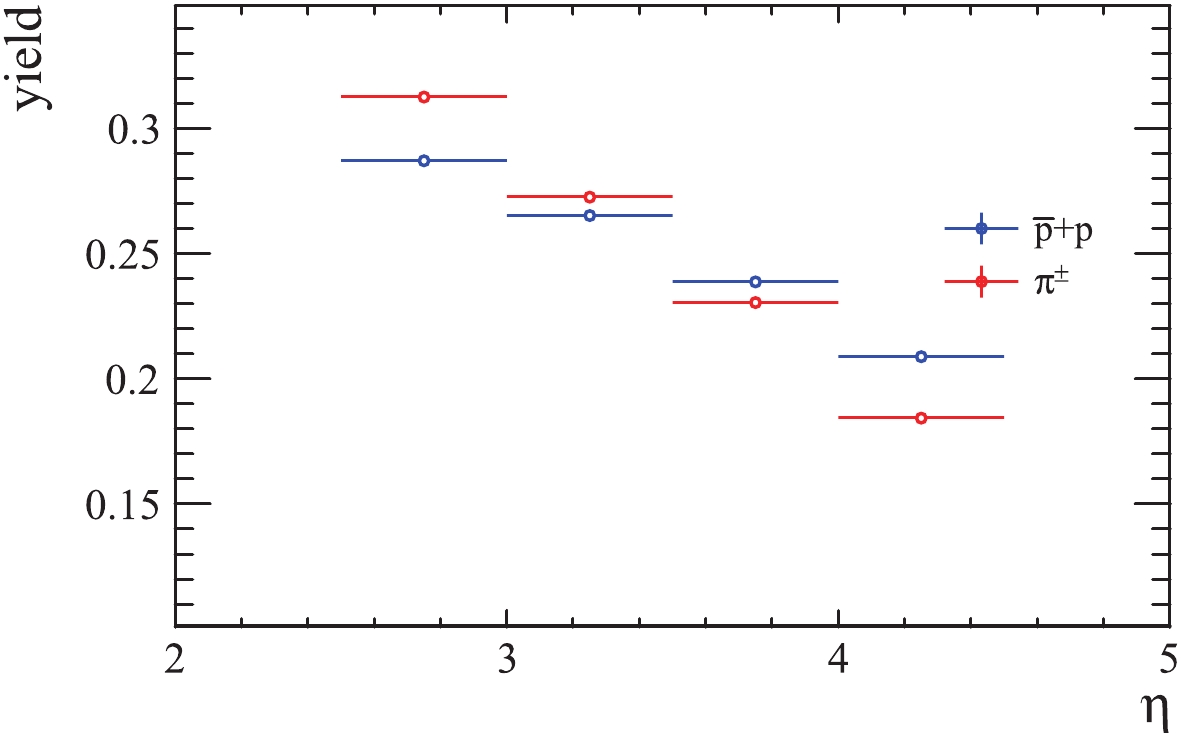 Figure8. (color online) Yields (normalized to 1) of protons and pions with
Figure8. (color online) Yields (normalized to 1) of protons and pions with 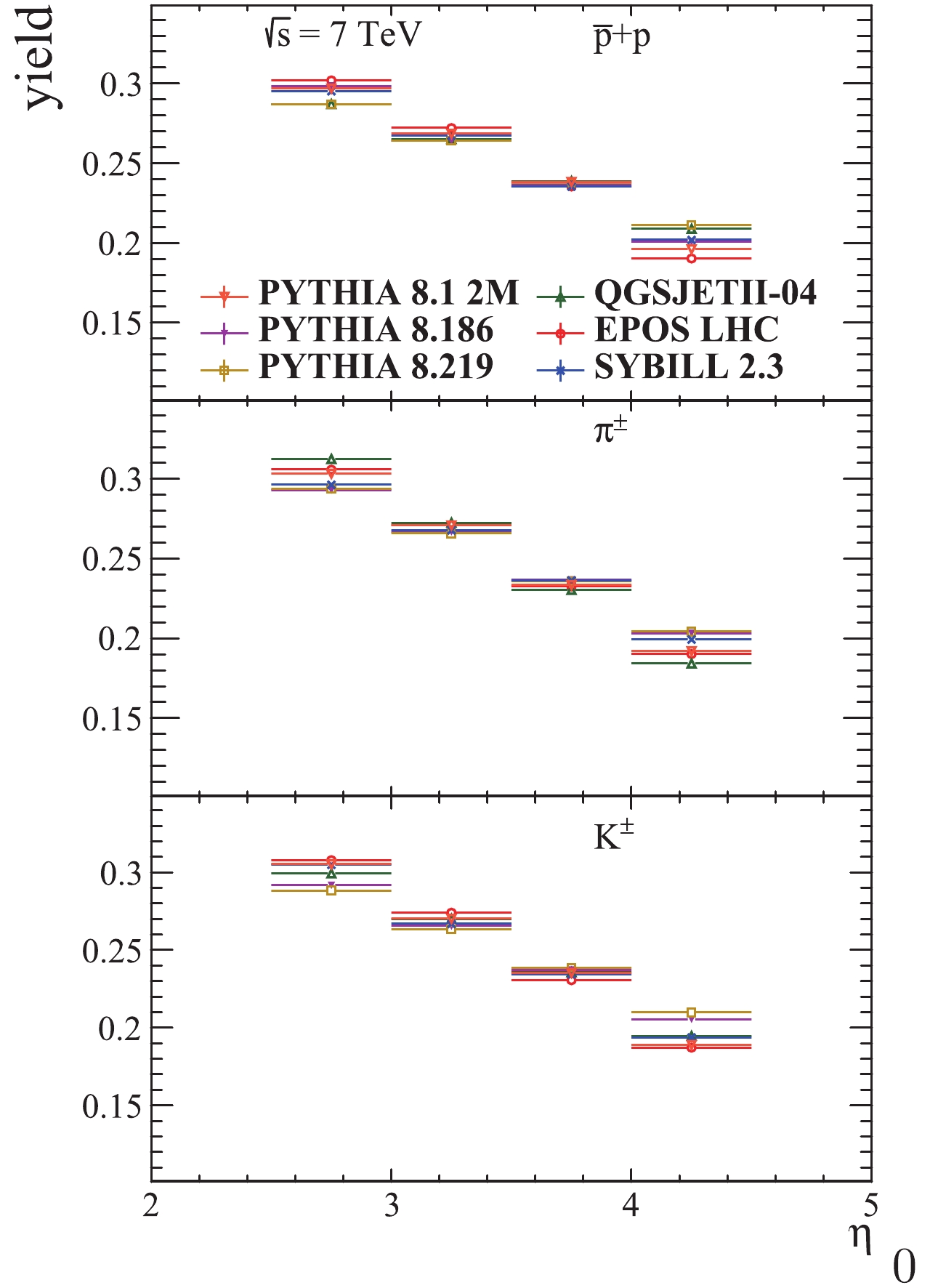 Figure7. (color online) Yields (normalized to 1) of protons, pions and kaons with
Figure7. (color online) Yields (normalized to 1) of protons, pions and kaons with As can be seen in Figs. 12-14, the
It was observed that the charged energy flow, which can be regarded as a global event observable, is relatively well described by all generators, at least in terms of shape. The best prediction overall for the charged energy flow is from SIBYLL 2.3, a generator tuned specifically to reproduce correctly this type of observable. PYTHIA 8.186 gives the best description of the other LHC-tuned generators.
EPOS and PYTHIA, especially version 8.219, are very similar in their description of the observables. The similarity between these generators may arise from the partonic approach and similar perturbative calculations that are used for hard parton collisions.
QGSJET is similar to EPOS in the description of some observables, like the charged energy flow (except for the hard event class) and charged particle densities, but also shares some similarities with SIBYLL.
The multiplicity distributions are generally not well reproduced by the generators. EPOS and PYTHIA give the best predictions overall. Also, they seem to get better with the increasing hardness of the processes, but exhibit a similar effect as the other generators, i.e. favoring either very low or high multiplicity events, albeit at a much lower level than SIBYLL, which has the most polarizing behavior.
SIBYLL has a few notable successes in describing some particle ratios. Also, its predictions for charged particle pseudorapidity and transverse momentum distributions have a good shape.
The best baryon transport mechanism seems to be that of EPOS, followed by PYTHIA, while the
Most of the observed differences seem to be an effect of extrapolation in the forward region, and the extrapolation uncertainties seem to be rather large. Nonetheless, in the majority of cases, the measurements fall within a band defined by the most extreme predictions.
The relative contributions of particle production processes differ between the central and forward regions. In the central pseudorapidity region, there is a significant contribution of hard parton-parton scatterings (with high squared momentum transfer), to which high multiplicity events and high pT jets are associated. In the forward region, on the other hand, the underlying events (multi-parton interactions and beam remnants), as well as diffractive processes, give a considerable contribution. The event generators usually have different sets of parameters for each process, and as such, when tuning using the measurements from one pseudorapidity region or the other, different parameters are constrained, so that each tune is applicable for studies in its respective region. As shown in this paper, the predictions in the forward region are improved by tuning the generators using the measurements from the central region, but it seems that a dedicated tuning procedure is still necessary. As a result, the effectiveness of each tune is somewhat limited when extrapolating from the central to the forward region and vice versa. Ideally, the measurements from both the forward and central regions should be used simultaneously when tuning a generator, but this is seldom done. In many cases there are intrinsic limitations of the generators, or of the models they are based on, which prevent a simultaneous tune in both regions, and hence a more consistent overall description of the processes. Difficulties related to such a tuning procedure also arise from the different experimental conditions in each region.
As we have seen in this paper, it seems that modeling of the soft processes is still open to improvement, and a tuning of generators is required to improve the precision in the forward rapidity range. Hence, it may prove useful for tuning to take into account the measurements from LHCb and TOTEM, the LHC experiments in the forward region, where the soft component is considerably larger than in the central region, the baryon transport is different, and the multi-parton collisions might give a different signal.
We would like to thank the authors of PYTHIA/EPOS/QGSJET/SIBYLL generators and the authors of the CRMC interface (T. Pierog, C. Baus, and R. Ulrich).


